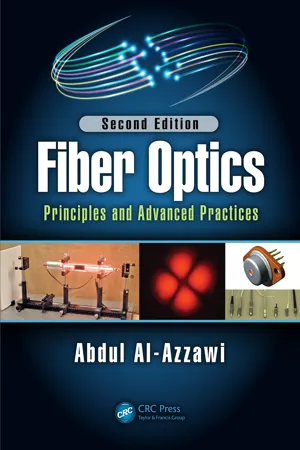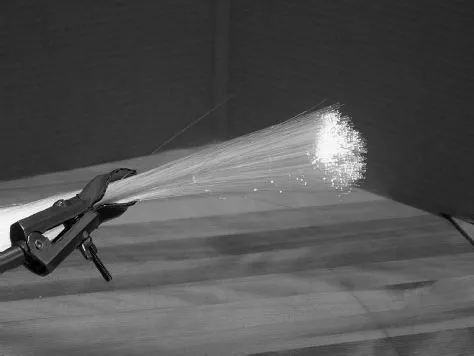
eBook - ePub
Fiber Optics
Principles and Advanced Practices, Second Edition
Abdul Al-Azzawi
This is a test
- 448 pages
- English
- ePUB (mobile friendly)
- Available on iOS & Android
eBook - ePub
Fiber Optics
Principles and Advanced Practices, Second Edition
Abdul Al-Azzawi
Book details
Book preview
Table of contents
Citations
About This Book
This book provides a step-by-step discussion through each topic of fiber optics. Each chapter explores theoretical concepts of principles and then applies them by using experimental cases with numerous illustrations. The book works systematically through fiber optic cables, advanced fiber optic cables, light attenuation in optical components, fiber optic cable types and installations, fiber optic connectors, passive fiber optic devices, wavelength division multiplexing, optical amplifiers, optical receivers, opto-mechanical switches, and optical fiber communications. It includes important chapters in fiber optic lighting, fiber optics testing, and laboratory safety.
Frequently asked questions
How do I cancel my subscription?
Can/how do I download books?
At the moment all of our mobile-responsive ePub books are available to download via the app. Most of our PDFs are also available to download and we're working on making the final remaining ones downloadable now. Learn more here.
What is the difference between the pricing plans?
Both plans give you full access to the library and all of Perlego’s features. The only differences are the price and subscription period: With the annual plan you’ll save around 30% compared to 12 months on the monthly plan.
What is Perlego?
We are an online textbook subscription service, where you can get access to an entire online library for less than the price of a single book per month. With over 1 million books across 1000+ topics, we’ve got you covered! Learn more here.
Do you support text-to-speech?
Look out for the read-aloud symbol on your next book to see if you can listen to it. The read-aloud tool reads text aloud for you, highlighting the text as it is being read. You can pause it, speed it up and slow it down. Learn more here.
Is Fiber Optics an online PDF/ePUB?
Yes, you can access Fiber Optics by Abdul Al-Azzawi in PDF and/or ePUB format, as well as other popular books in Ciencias físicas & Óptica y luz. We have over one million books available in our catalogue for you to explore.
Information
1 | Fibre-Optic Cables |

1.1 INTRODUCTION
Fibre-optic cables transmit data through very small cores at the speed of light. Significantly different from copper cables, fibre-optic cables offer high bandwidths and low losses, which allow high data-transmission rates over long distances. Light propagates throughout the fibre cables according to the principle of total internal reflection.
There are three common types of fibre-optic cables: single-mode, multi-mode and graded-index (GRIN). Each has its own advantages and disadvantages. There are also several different designs of fibre-optic cables, each made for different applications. In addition, new fibre-optic cables with different core and cladding designs have been emerging; these are faster and can carry more modes. Although fibre-optic cables are mostly used in communication systems, they also have established medical, military, scanning, imaging and sensing applications. They are also used in optical fibre devices and fibre-optic lighting.
This chapter will discuss the fabrication processes used in manufacturing fibre cables. The processes produce a thin flexible glass strand with a diameter even smaller than that of human hair. This chapter will also detail methods of coupling a light source with a fibre cable in the manufacturing of optical fibre devices. It will also compare fibre and copper cables and describe the applications of fibre-optic cables in many fields and sectors of modern society. Finally, this chapter will present four experimental cases, including fibre cable inspection and handling, fibre cable end preparation, numerical aperture measurements and calculations and fibre cable power output intensity measurements and calculations.
1.2 THE EVOLUTION OF FIBRE-OPTIC CABLES
The evolution of optical communication systems dates back to the early 1790s, when the French engineer Claude Chappe (1763–1805) invented the optical telegraph. His system involved a series of semaphores mounted on towers, where human operators relayed messages from one tower to the next. This was certainly an improvement over hand-delivered messages. But by the mid-nineteenth century, the optical telegraph was replaced by the electric telegraph, leaving behind a legacy of Telegraph Hills, San Francisco.
In 1841, Swiss physicist Daniel Colladen (1802–1893) and French physicist Jacques Babinet (1794–1872) showed in their popular science lectures that light could be guided along jets of water for fountain displays. Then in 1870, Irish physicist John Tyndall (1820–1893) demonstrated the light-pipe phenomenon at the Royal Society of England. Tyndall directed a beam of sunlight into a container of water and opened the spout. Water flowed out in a jet, and the pull of gravity bent the water into a parabolic shape, as shown in Figure 1.1. Light was trapped inside the water jet by the total internal reflection phenomenon. The light beam bounced off the top surface, then off the lower surface of the jet, until turbulence occurred in the flowing water and broke up the beam. This experiment marked the first research into the guided transmission of light by an interface between two optical materials.
In 1880, Alexander Graham Bell patented an optical telephone system that he called the photophone, but his earlier invention—the telephone—proved far more practical. Although Bell dreamed of sending signals through the air, the atmosphere did not transmit light as reliably as wires carried electricity. For the next several decades, though light was used for a few special applications such as signalling between ships, inventions using optical communication gathered dust on the shelf. Bell donated his photophone to the Smithsonian Institution, Washington, DC.
Ultimately, a new light-guiding technology that slowly took root solved the problem of optical transmission. The technology depended on the phenomenon of total internal reflection, which can confine light in an optical material that is surrounded by another optical material with a lower refractive index, such as glass in air. However, it was a long time before this method was adapted for communications.

FIGURE 1.1 Total internal reflection of light in a water jet.
Optical fibres went a step further. These are essentially transparent rods of glass or plastic stretched until they are long and flexible. During the 1920s, John Logie Baird in England and Clarence W. Hansell in the United States patented the idea of using arrays of hollow pipes or transparent rods to transmit images for television or facsimile systems. British Patent Spec 20,969/27 was registered to Baird, and U.S. Patent 1,751,584 was granted to Hansell in 1930 for the scanning and transmission of a television image via fibres. Also in 1930, H. Lamm, in Germany, demonstrated light transmission through fibres. The next reported activity in this field took place in 1951, when A. C. S. van Heel in Holland and Harold H. Hopkins and Narinder S. Kapany of Imperial College in London investigated light transmission through bundles of fibres. Although van Heel coated his fibres with plastic, Kapany explored fibre alignment, and as reported in his book, Fibre Optics, produced the first undistorted image through an aligned bundle of uncoated glass fibres.
Neither van Heel nor Hopkins and Kapany made bundles that could carry light far, but their reports sparked the fibre optics revolution. The crucial innovation was made by van Heel, stimulated by a conversation with the American optical physicist Brian O’Brien. Although all earlier fibres were bare, with total internal reflection at a glass–air interface, Heel covered a bare fibre of glass or plastic with a transparent cladding of lower refractive index. This protected the total reflection surface from losses and greatly reduced crosstalk between fibre cables. The next key step was the development of glass-clad fibres by Lawrence Curtiss at the University of Michigan, Ann Arbor, Michigan. By 1960, glass-clad fibres had reached an attenuation of about one decibel per metre, which was fine for medical imaging, though much too high for communications.
In 1958, higher optical frequencies seemed the next logical step to Alec Reeves, the forward-looking engineer at Britain’s Standard Telecommunications Laboratories, Harlow, Essex, who invented digital pulse-code modulation before the Second World War. Other people climbed on the optical commu...
Table of contents
Citation styles for Fiber Optics
APA 6 Citation
Al-Azzawi, A. (2017). Fiber Optics (2nd ed.). CRC Press. Retrieved from https://www.perlego.com/book/1510768/fiber-optics-principles-and-advanced-practices-second-edition-pdf (Original work published 2017)
Chicago Citation
Al-Azzawi, Abdul. (2017) 2017. Fiber Optics. 2nd ed. CRC Press. https://www.perlego.com/book/1510768/fiber-optics-principles-and-advanced-practices-second-edition-pdf.
Harvard Citation
Al-Azzawi, A. (2017) Fiber Optics. 2nd edn. CRC Press. Available at: https://www.perlego.com/book/1510768/fiber-optics-principles-and-advanced-practices-second-edition-pdf (Accessed: 14 October 2022).
MLA 7 Citation
Al-Azzawi, Abdul. Fiber Optics. 2nd ed. CRC Press, 2017. Web. 14 Oct. 2022.